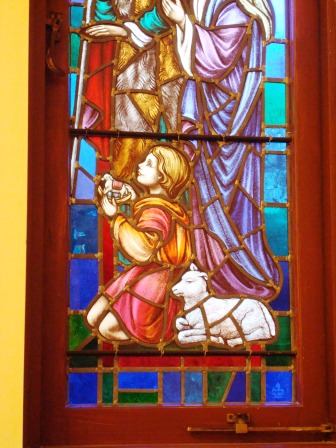WDTPRS: 4th Sunday of Advent - COLLECT (2002MR)
 The Collect for this Sunday is the Post-communion of the Feast of the Annunciation (25 March) in the 1962MR. Most of you who recite the Angelus know this prayer.
The Collect for this Sunday is the Post-communion of the Feast of the Annunciation (25 March) in the 1962MR. Most of you who recite the Angelus know this prayer. This time we also get the WDTPRS version since we want to know what the prayer really says. This is also the prayer said traditionally after the Alma Redemptoris Mater, sung following Compline during Advent.
COLLECT - LATIN TEXT (2002MR):
Gratiam tuam, quaesumus Domine,
mentibus nostris infunde,
ut qui, Angelo nuntiante,
Christi Filii tui incarnationem cognovimus,
per passionem eius et crucem
ad resurrectionis gloriam perducamur.
The last part, per passionem eius et crucem ad resurrectionis gloriam perducamur has a wonderful flow to it with its alliteration and snappy cadence, followed as it is by the rhythmically gear changing conclusion, Per Dominum nostrum Iesum Christum…. Collects are often little masterpieces. They deserve great care in rendering them into a liturgically smooth, yet accurate version. In WDTPRS we are purposely being rather “slavish” in translating so you can see the raw text. Imagine how hard it is to work up good liturgical versions.
We never have to brush dust from our frequently exploited Lewis & Short Latin Dictionary. Therein we find that cognosco is, generally, “to become thoroughly acquainted with (by the senses or mentally), to learn by inquiring…”, but in the perfect tenses (cognovimus) it is “to know” in all periods of Latin. The verb infundo basically is “to pour in, upon, or into” but in the construction (which we see today – infundere alicui aliquid) “to pour out for, to administer to, present to, lay before”. Simply, it can mean, “communicate, impart”. The verb perduco “to lead or bring through”, is “guide a person or thing to a certain goal, to a certain period”. Interestingly, both infundo and perduco can have the overtone of to anoint, or smear with something.
ICEL (1973 translation of the 1970MR):
Lord,
fill our hearts with your love,
and as you revealed to us by an angel
the coming of your Son as man,
so lead us through his suffering and death
to the glory of his resurrection
for he lives and reigns…
A TRADITIONAL VERSION:
Pour forth, we beseech Thee, O Lord, Thy grace into our hearts, that we, to whom the incarnation of Christ, Thy Son, was made known by the message of an angel, may by His Passion and Cross be brought to the glory of His resurrection, (through the same Christ our Lord).
Some people think that “Thee” and “Thou” are formal. Au contraire! These are familiar forms of pronouns for the second person singular used by a superior to an underling or between equals or friends. The “you” form (derived from “ye”) is the more formal! In traditional prayers (Our Father, who art in heaven, hallowed by Thy name…) we address God with a familiar, intimate form not so common today unless you are Amish or Quaker. You will raise an eyebrow or two at the bowling alley if you shift to “thou”: “Since it’s the tenth frame and thou hadst a strike, thrice canst thou bowl. Take up thy ball and bowl, already, ‘cause I gotta go home.”
Well… that last phrase shows some ICEL influence, but I think you get my drift.
I know the new translation is coming, and that it marks a huge improvement over the lame-duck massacre we are using now, but I often wish we could have had a version with all the "thees and thous". A more archaic, stylized prayer could have cut across differences between, say, the English of Africa, Australia, and Asia. They say Americans and British are two peoples separated by a common language. But not when we read Shakespeare or we say the traditional Our Father! The CDWDS document for the norms of translation, Liturgiam authenticam, says that the language of liturgy should be distinct from daily speech:
27. Even if expressions should be avoided which hinder comprehension because of their excessively unusual or awkward nature, the liturgical texts should be considered as the voice of the Church at prayer, rather than of only particular congregations or individuals; thus, they should be free of an overly servile adherence to prevailing modes of expression. If indeed, in the liturgical texts, words or expressions are sometimes employed which differ somewhat from usual and everyday speech, it is often enough by virtue of this very fact that the texts become truly memorable and capable of expressing heavenly realities. Indeed, it will be seen that the observance of the principles set forth in this Instruction will contribute to the gradual development, in each vernacular, of a sacred style that will come to be recognized as proper to liturgical language. Thus it may happen that a certain manner of speech which has come to be considered somewhat obsolete in daily usage may continue to be maintained in the liturgical context.Anyway, it couldn’t have hurt. But that is not going to happen… unless…. unless…
Maybe we could have a petition.... "What if we just said ‘Thee’?" ... How would be vote?
n
n
In an English translation of the Roman Missal what style would you prefer?
LITERAL TRANSLATION:
We beg You, O Lord,
pour Your grace into our minds and hearts,
so that we who came to know the incarnation of Christ Your Son
in the moment the Angel was heralding the news,
may be guided through His Passion and Cross
to the glory of the resurrection.
Angelo nuntiante is an ablative absolute, hard to render in English without using a paraphrase. The participle nuntiante is in the present tense, or better, in a tense “contemporary” with the time of the verb cognovimus having a past tense. Thus, in the very moment the Angel was heralding the good news, we (collectively in the shepherds) knew about how God the Son Eternal took our whole human nature perfectly into an indestructible bond with His divinity.
 Good Advent shepherds, they rushed to the Coming of the Lord, to see the Word made flesh lying in the wooden manger. “Seeing is believing”, they say, but believing makes us want to see! “Crede ut intellegas! Believe that you may understand!” is a common theme for St. Augustine (e.g., s. 43,4.7; 118,1; Io. eu. tr. 29,6).
Good Advent shepherds, they rushed to the Coming of the Lord, to see the Word made flesh lying in the wooden manger. “Seeing is believing”, they say, but believing makes us want to see! “Crede ut intellegas! Believe that you may understand!” is a common theme for St. Augustine (e.g., s. 43,4.7; 118,1; Io. eu. tr. 29,6). Today many people automatically oppose faith against reason, authority versus intellect, as if they were mutually exclusive. In fact, faith and authority are indispensable for a deeper rational, intellectual apprehension of anything. In all the deeper questions of human existence, we need the illumination from grace, we must believe and receive. Faith is the foundation of our hope which leads to love and communion with God, as Augustine might say (trin. 8,6).
The Angel heralded with authority. The shepherds believed. They rushed to Bethlehem. They saw the Infant. They understood the message. Then they worshiped the Word made flesh Who opened for them a new life.
How often do we hear about something or learn a new thing and then rush to know more, to have personal experience, to see?
Think about this. If you had been told in the night by angels to go somewhere, do you think you would roll over and say "It can wait"? Would you, stroll? Saunter?
I think I would run until my lungs burst.
This is a paradigm for our life of faith. There is an interlocking cycle of hearing a proclamation (such as the Gospel at Mass, a homily, or a teaching of the Church) or observing the living testimony of a holy person’s life, and by this experience coming to know and then love the content of that proclamation or living testimony. The content is the Man God Jesus Christ. By knowing Him we come all the better to love Him and in loving Him we desire better to know Him.
An act of faith, acceptance of the authority of the content of what we receive, opens unto previously unknown territory, a vast depth otherwise closed to us. For the non-believer, on the other hand, a miracle is simply something inexplicable having nothing of the supernatural.
For a non-believer being nice or hard working can never ascend to true virtue or holiness. For him, the content of the Faith itself (both Jesus as well as what we learn and assent to) appears to be pleasant or interesting, but in the end remains naïve or foolish.
As we rush into Advent’s final days, that first candle we lit on our wreaths is now quite depleted.
From 17 December to Christmas Eve solemn days envelop us and the haunting “O Antiphons” of vespers one after another cloak us in our longing: “O come! O come!.. to teach us… redeem us… deliver us… ransom us… free us… enlighten us… save us… save us….”
We are deeply wrapped within our penitential holyday cheer because our celebration of the Lord in His First Coming is near to hand, but we do not forget that His Second Coming will bring our final judgment.
No comments:
Post a Comment